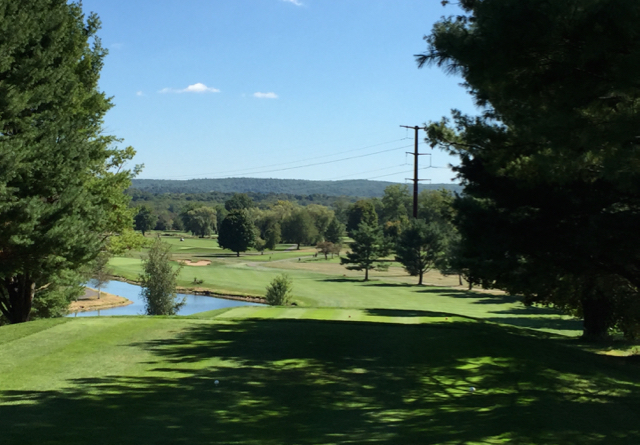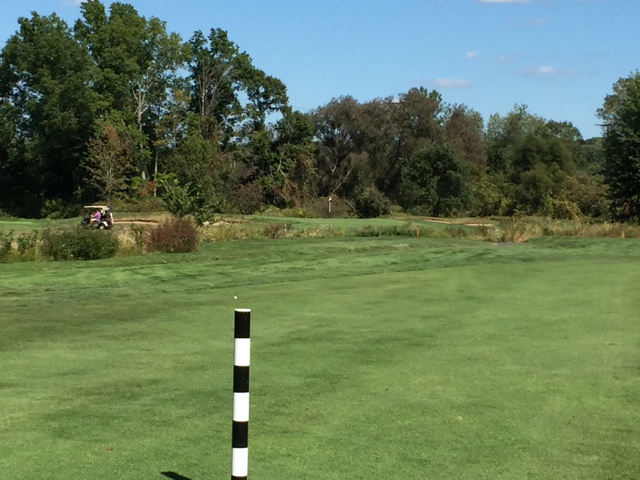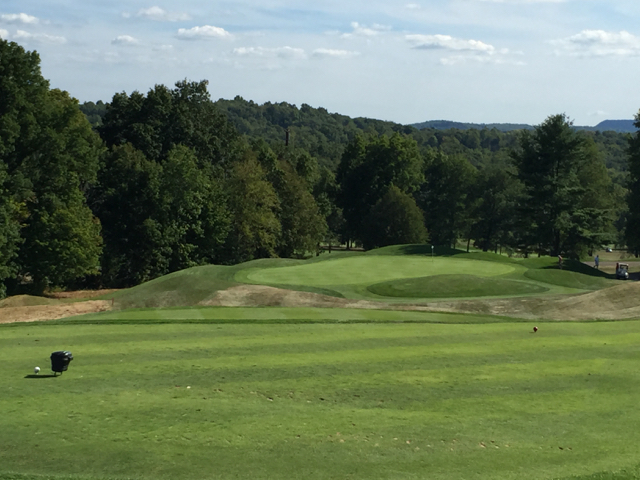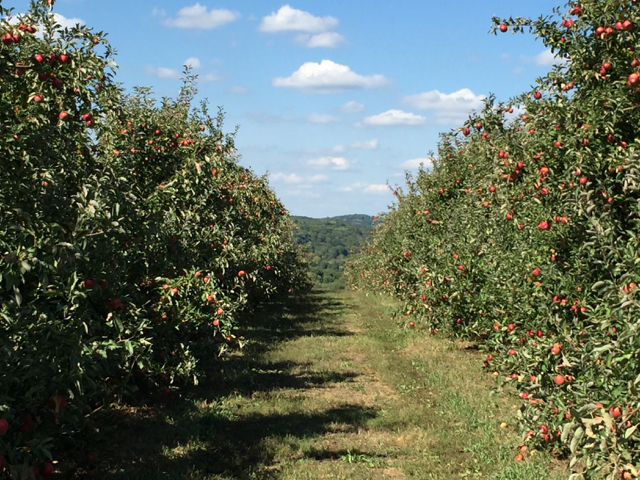LINKS magazine is out with an email today about the best golf courses to play when autumn leaves start to take on some color. As always for LINKS, the accompanying photographs are lush and beautiful. Click here for the article.
I especially appreciated the LINKS article because, just yesterday, I played a Robert Trent Jones course that could be a contender for LINKS’ top 10 Fall Golf Course list. Lyman Orchards is located in central Connecticut, in the town of Middlefield, and as the name implies, is set beside an apple orchard. However, the Jones course (circa 1969), which shares the complex with a more recently opened Gary Player course, wends its way through former farm land with clusters of pine and maple trees for background and extra challenge; the apples are left for the slightly longer and more challenging Player layout. After my round, I drove up to the rows and rows of apple-laden trees and had a lot of fun maneuvering my golf cart up and down the rows, stopping to pluck a Macintosh here, a Macoun there and a few sour green apples. The landing area on #10 at Lyman Orchards' Jones course seems very narrow, but those trees on the right force a drive that must challenge the water.
The landing area on #10 at Lyman Orchards' Jones course seems very narrow, but those trees on the right force a drive that must challenge the water.
It reminded me of another impressive orchard course, Orchard Creek, just west of Albany, NY, where I followed my son during a junior golf tournament 12 years ago. Each fairway was lined with apple trees bearing different breeds of apples; by the 4th hole, I was starting to suffer a stomach ache after having picked and eaten one per hole.
I was hell bent on some revenge on the Jones course yesterday. The only other time I played the course was 25 years ago, shortly after I moved to Connecticut from Manhattan. On the first hole, I snap hooked my drive into the lake on the left; it set the tone for a horrible round. Over the years, Lyman Orchard switched the nines, and I had to wait until #10 this time around. This time I made sure to aim down the far right side and, once again, pull hooked my shot, dribbling it into the water. I won’t wait another 25 years to have another go at it. The 14th at Lyman Orchards' Jones course isn't long but requires a deft approach shot over a nasty looking stream.
The 14th at Lyman Orchards' Jones course isn't long but requires a deft approach shot over a nasty looking stream.
The course was in wonderful condition, the greens smooth, large and undulating. Jones the elder guards them well with bunkers, but there always seems an option to enter directly from the front, although with many false fronts that make full carries pretty much the only way to get close. The starter explained to me that the green superintendent uses a new type of aeration that sends just a few tines into the turf and then distributes a burst of air underground. That means the few aeration holes make putting almost normal a day or two after the aeration process. Thankfully, the greens were quite receptive, even though that part of Connecticut hasn’t seen much rain lately; perhaps it is all that air they blow under the greens. The Gary Player layout at Lyman Orchards, which features rows of apples just off a few of the fairways, is considered the tougher of the two layouts. Judging by one of its par 3s, we understand.
The Gary Player layout at Lyman Orchards, which features rows of apples just off a few of the fairways, is considered the tougher of the two layouts. Judging by one of its par 3s, we understand.
Although there are really no blind holes on the course -– I understand there are some on the Player layout next door -– I found some golf balls tough to find even after well struck and straight shots. My drive on the par 5 4th hole pretty much ruined my day. Per the instructions of my playing partners, who know the course well, I flew my tee shot over the fairway bunker that cut into the left side of the fairway about 200 yards out. We watched it bounce once beyond the right center of the bunker, but when we got to the fairway, it was nowhere to be found. Five minutes later, after scouring the rough on both sides, I threw down another ball, angry and frustrated. I don’t mind losing one in the woods, but this ball should have been center cut.
How’d I like them apples? Not very much. When you play the Gary Player 18 in late September or October at Lyman Orchards, you can divert for a little refreshment just off a few of the fairways.
When you play the Gary Player 18 in late September or October at Lyman Orchards, you can divert for a little refreshment just off a few of the fairways.



